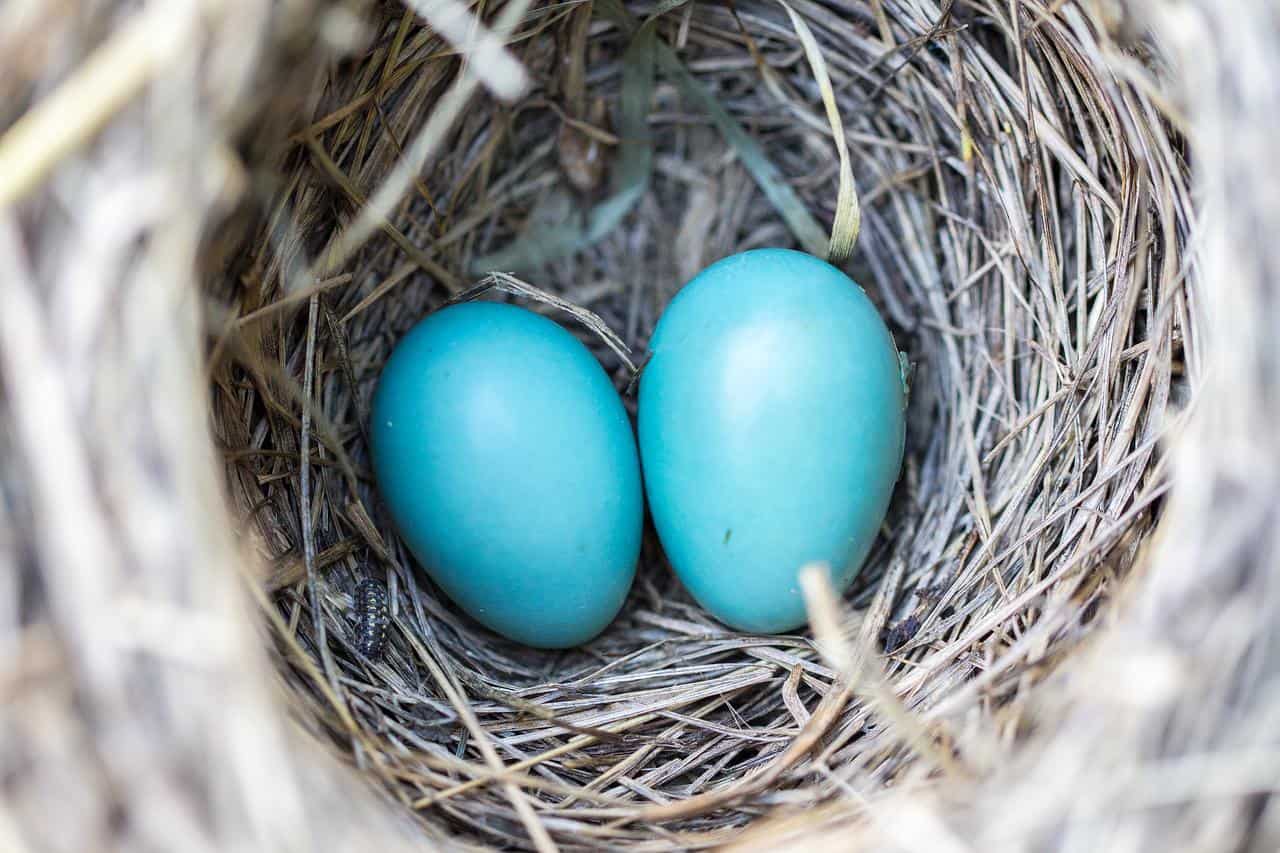Discover the eastern bluebird nesting habits from start to finish. Learn the materials bluebirds use to build their nest, where they build it, and how to identify their nest from other birds’ nests.
If you’ve not already hosted a bluebird pair raising their young in your yard, I’m willing to bet you want to. It’s an amazing experience to observe mom and dad bluebird build their nest, lay their eggs, and raise the young to the point where they fledge the nest. It all starts with creating the perfect home for their family – the nest.
In this article, I’ll walk through the chronological nesting habits of a bluebird pair starting with when nesting begins, who builds the nest, what materials the nest is made from, what the nest ultimately looks like when complete, and lots of other interesting tidbits about bluebird nests and their nesting habits.
With more than 25 years of experience hosting backyard birds and having numerous bluebird pairs settle and raise their young in one of my nesting boxes, I’m well-versed in bluebird nests and their nesting behavior. Of course, I don’t know everything so rely on trusted online resources (including www.sialis.org, and www.allaboutbirds.org) as well as print guides (The Bluebird Monitor’s Guide) to fill in the gaps.
In case you weren’t aware, there are three birds in the bluebird family – the eastern bluebird, the western bluebird, and the mountain bluebird. This article is about the eastern bluebird. For simplicity’s sake, I’ll refer to this bird as just a “bluebird”.
Bluebirds’ Primary Mission: Successful Reproduction
Like all wild animals, the primary mission in life for bluebirds is to reproduce. The more healthy babies they can produce – the better.
During the breeding season, all decisions are run through the filter “will this increase our chance for reproductive success”? There are a few key decisions made early on that directly affect the bluebirds’ reproduction success:
- Choosing a mate: It’s the female bluebird that decides who to mate with. The male bluebird defines its territory and identifies potential nesting sites within it. His goal is to woo a female based on the quality of his territory and nesting site options. The better the territory – rich with food (insects) and a habitat that supports their hunting style (open area with plenty of elevated perch sites to scan for insects) – the greater his chances are of being selected as her mate.
- Selecting the nesting site: The ideal nesting site, safe from predators, increase the chances for reproductive success because the pair can focus more on raising babies vs defending and fighting off aggressors.
- Begin nesting early: The sooner the first clutch is laid the more subsequent opportunities there are in a given season.
The Eastern Bluebird Nesting Season
Depending on where the eastern bluebirds live within their range, the breeding season may start as early as February and can go as late as September – although late July is more common.
Bluebirds in the southern part of their range begin their mating and nesting activities earlier than the ones in the north.
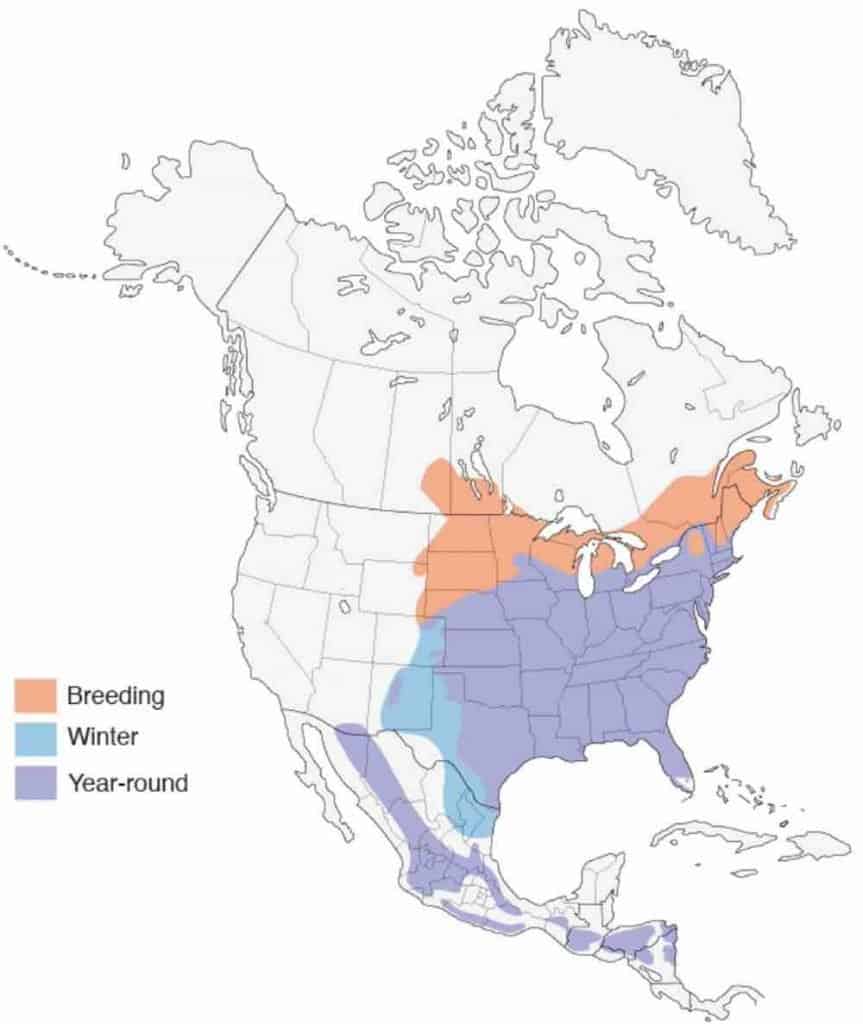
Male bluebirds spend February and March establishing their territories and attracting a mate. Nesting building begins soon after – around early March to the middle of April.
Getting an early start has many benefits for the bluebird pair such as:
- It provides more opportunities to have more broods and successfully raise healthy offspring. (Studies have shown only 60% of all bluebird nests are successful.)
- It enables them to avoid their common aggressors – house wrens and house sparrows – as they’ve not yet migrated back.
- It helps them avoid nest-killing bugs, such as ants and blowflies, as they’re not yet a problem while temperatures remain lower.
On the flip side, there are drawbacks to early nesting including:
- The wet and cold temperatures can cause the eggs or nestlings to die of exposure.
- There are fewer food options so not only do the pair spend more time further away from the nest, they have less food to feed the young which leads to starvation.
Selecting the Nesting Site
Bluebirds are “cavity-nesters” which means they build their nest inside a cavity. Popular cavity options include:
- Natural tree cavity (e.g. inside an old woodpecker hole).
- A manmade nestbox.
- A crevice.
Bluebirds are just one species of cavity-nesting bird, or more specifically “secondary cavity-nesters” (meaning they use existing cavities vs. excavating their own). The other species that will be used in a bluebird nesting box include nuthatches, chickadees, house wrens, house sparrows, tree swallows, and downy woodpeckers – to name a few.
There are only so many old woodpecker holes to go around so you can imagine the fierce competition they face when trying to find one that meets their preferred habitat – an open area with low vegetation for easy foraging.
Enter the manmade nestbox.
Bluebirds are more than happy to nest and raise their young in a manmade nestbox. If it’s located in an open area with low vegetation – even better! They’re ground eaters so this type of habitat enables them to sit on a perch and look for insects on the ground before diving in to snatch them up.
However, bluebirds have been known to select a nesting box outside their typical habitat. A few years ago a bluebird pair decided to nest in a decorative birdhouse just outside my front window. Great for me because I had a front-row view! Not so great for them because they spent a lot of time and energy defending themselves against extremely aggressive non-native house sparrows, and (native) house wrens.
If you’re interested in putting up a bluebird nesting box, be sure to take the proper precautions for mounting and placement of the box to ensure the safety of the bluebird family. Check out Bluebird House Placement.
The male bluebird is like a real estate agent. He identifies several potential nesting sites within his territory and shows them to the female. As mentioned earlier, the female likely has selected her groom based on the quality of his territory which includes a selection of viable nesting sites.
The female bluebird is like the home buyer. She explores each of the nesting sites, usually popping in and out of each cavity numerous times, before selecting one. Once she’s made a decision, nest construction begins a few hours to a few days later.
Below is a short clip of a female bluebird exploring one of my nesting boxes. Ultimately she did not build a nest in it.
According to sialis.org, if both the males and females explore the cavity together, it’s a strong indication that will be the selected nesting site.
Nest Construction
While the male bluebird brings the nesting material to the nesting site, it’s the female that actually builds the nest. Nest materials include fine grasses, weeds, twigs, and/or pine needles. Sometimes they’ll also include animal fur, feathers, and/or rootlets.
The female bluebird typically takes 4-5 days to complete building the nest. However, she may only take a couple of days -or- she may take up to six weeks. In some cases, she’ll work on building multiple nests simultaneously at different sites but will only complete one of them to lay her eggs.
Using the materials brought in by the male as well as additional materials she collects, the female bluebird embarks on nest construction. This essentially requires weaving the materials into a cup shape along with beak and wing maneuvers to push and place the grasses and twigs into place. It truly is a work of art.
What better way to describe how she builds the nest than to show you the video below?
Have you noticed she appears to put a lot of thought into what and where the material will go? It’s not uncommon for her to take materials out if she determines it’s not worthy for some reason. The short clip below illustrates this behavior.
What does a bluebird nest look like?
The completed bluebird nest looks like a tidy, cup-shaped, wall-to-wall collection of fine grasses, weeds, twigs, pine needles, animal fur, feathers, and/or rootlets. Home sweet home 🙂
It’s relatively easy to identify a bluebird nest. Unlike other cavity nesters, bluebird nests are relatively neat and tidy. They take on a round appearance with a shallow depression in which to hold the clutch of eggs.
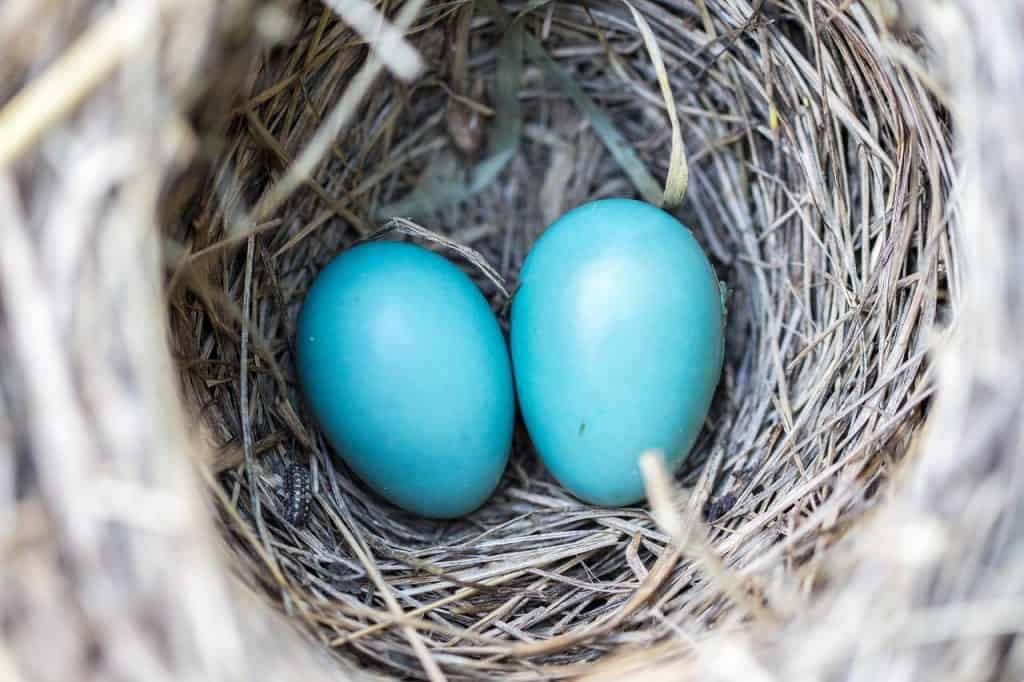
Of course not all bluebird nests are identical. Below is a sampling of completed bluebird nests, in a range of baby development stages, that illustrate the slight variations.
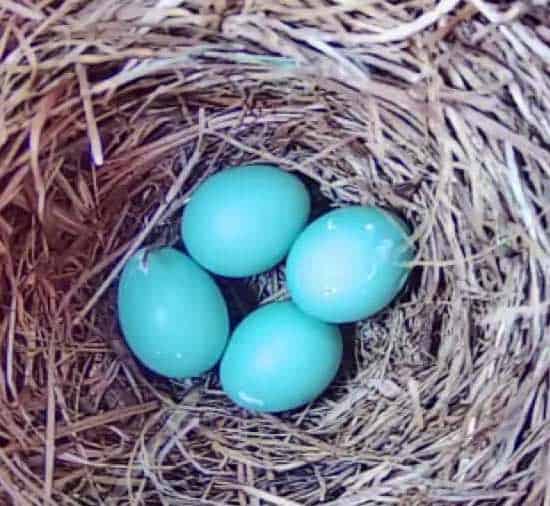
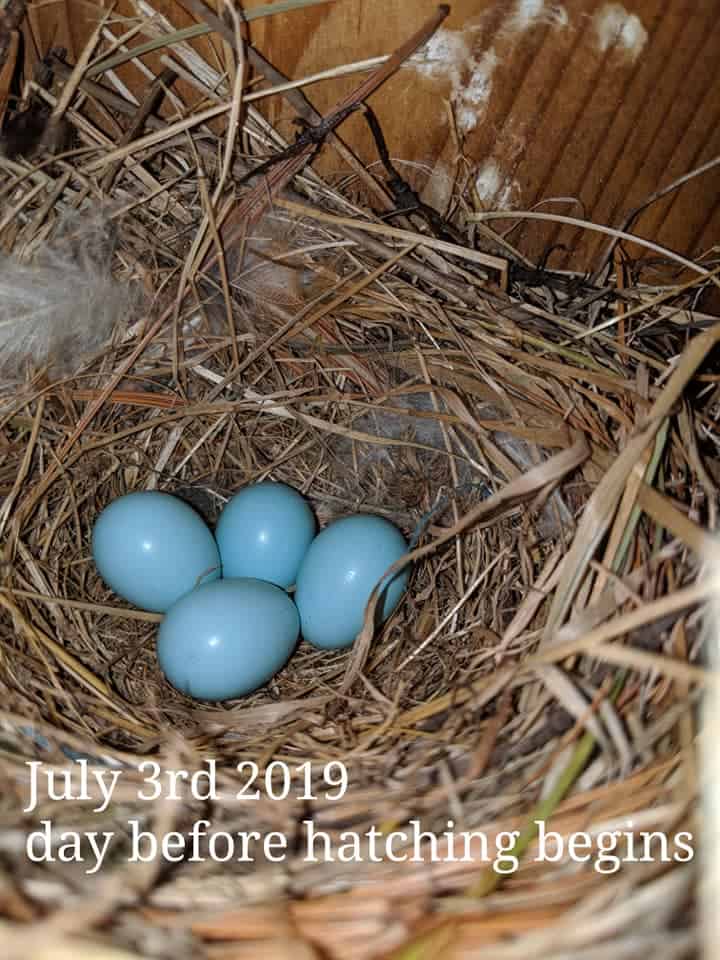
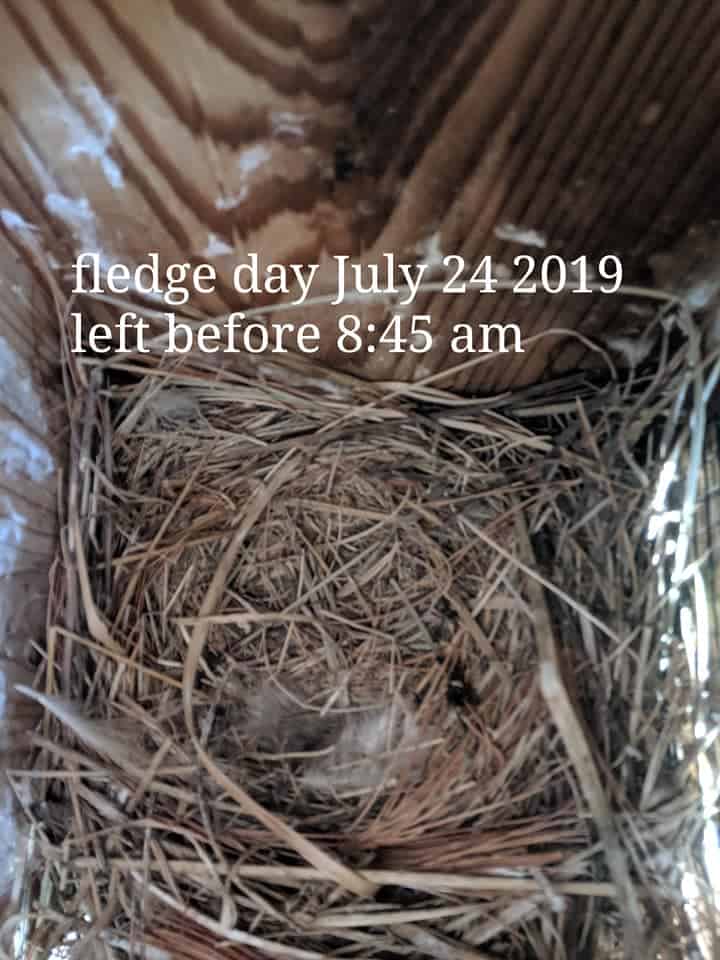
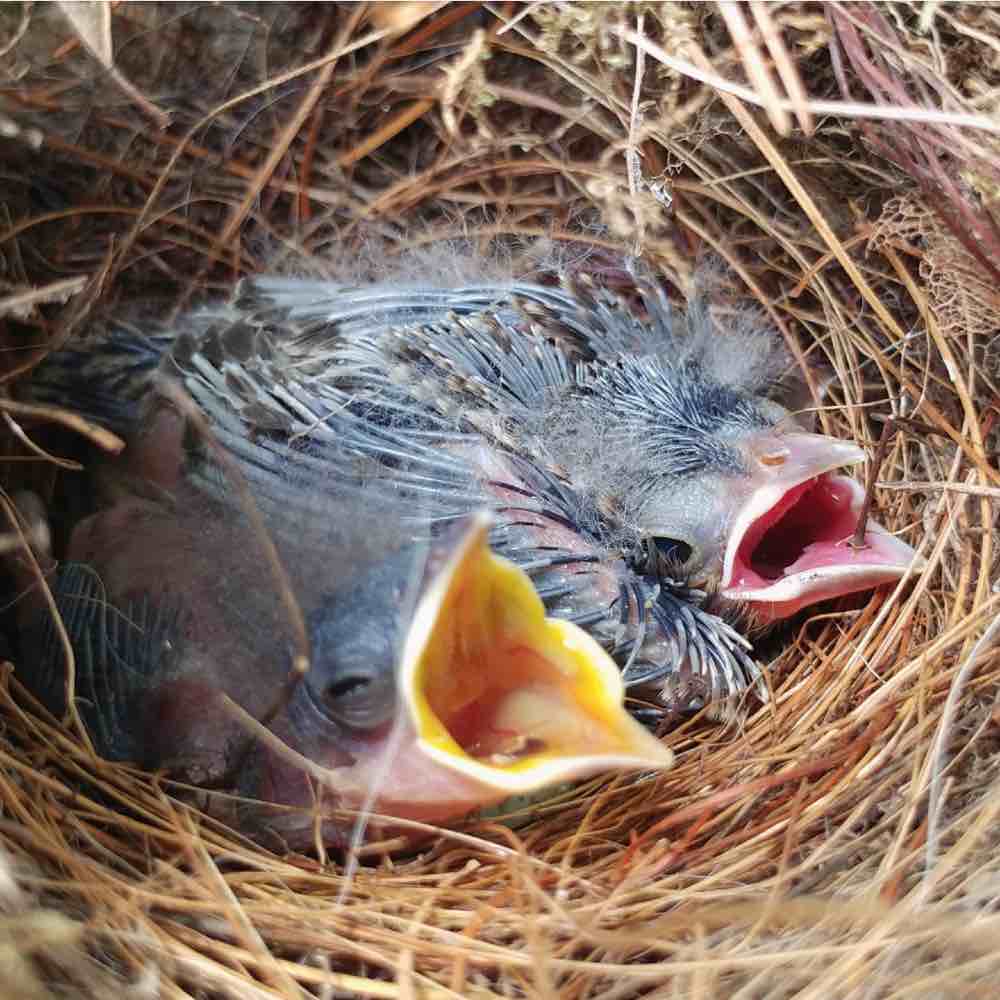
For those of us who love visuals, here are the eastern bluebird nesting steps in an infographic:
Bluebird vs Sparrow Nest
The two photos below show the clear distinction between an eastern bluebird and a house sparrow nest.
Eastern Bluebird Nest

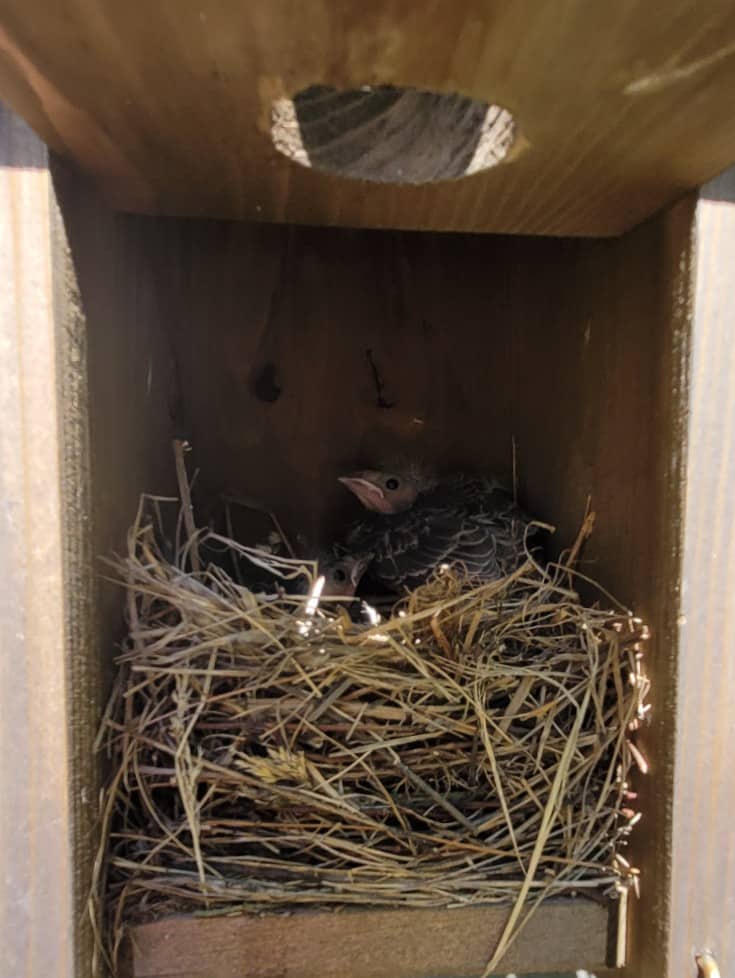
House Sparrow Nest
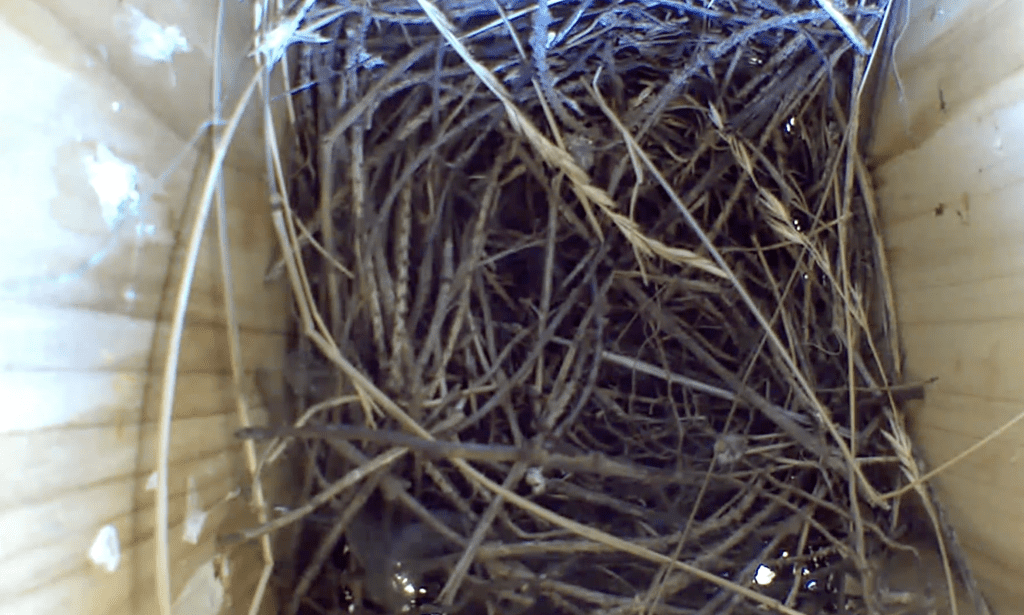
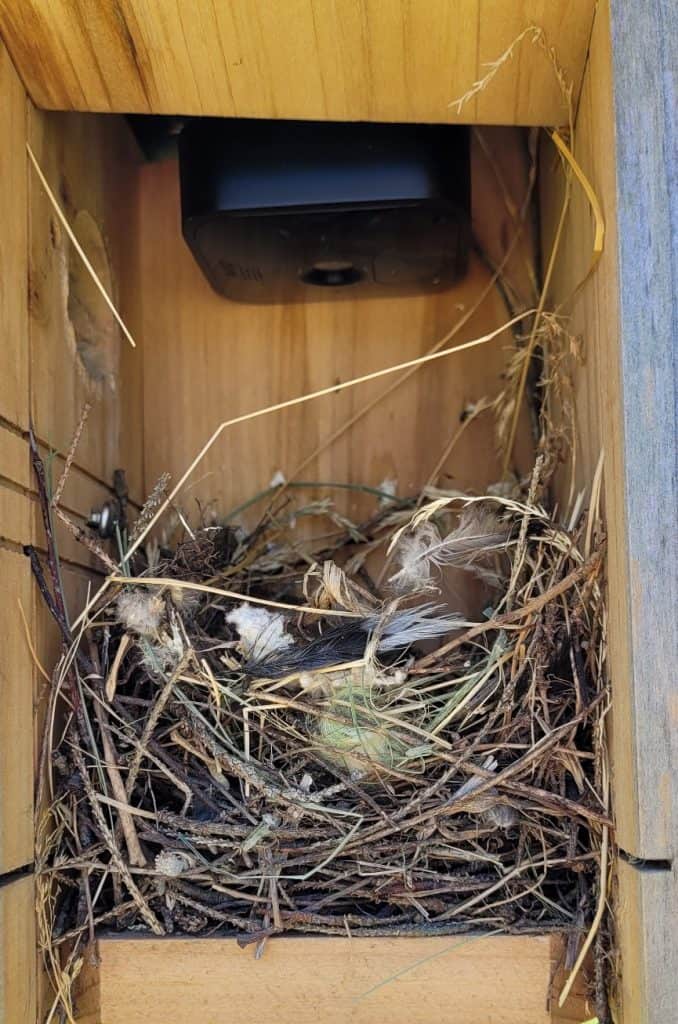
The bluebird nest is relatively shallow and tidy with grasses being the predominant material weaved around into a cup shape.
The house sparrow nest is messy with no apparent shape. Twigs are the primary material used but they also use leaves, string, feathers, and just about any type of material that flies by while they are building.
Bluebird vs House Wren Nest
The two photos below show the clear distinction between an eastern bluebird and a house wren nest.
Eastern Bluebird Nest


House Wren Nest
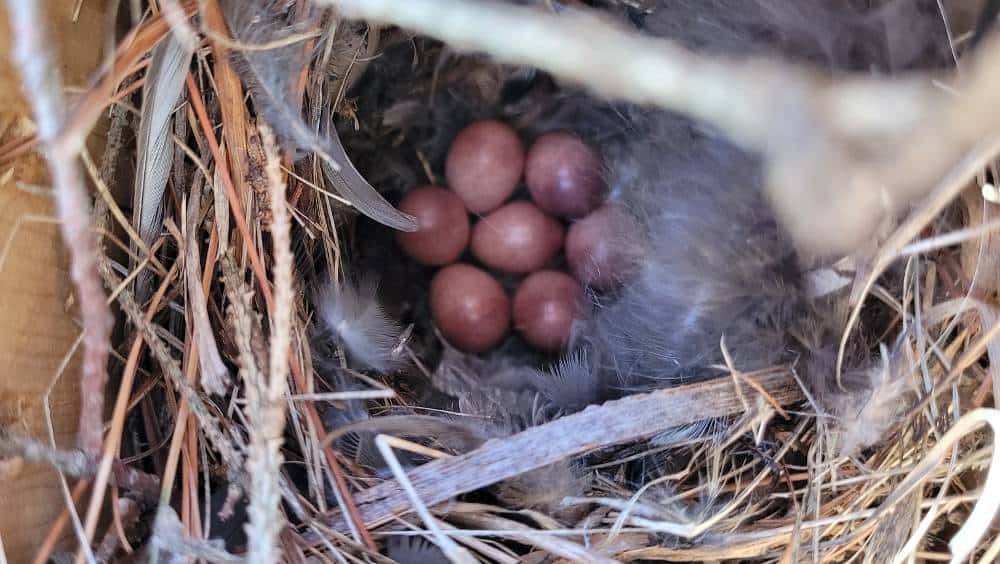
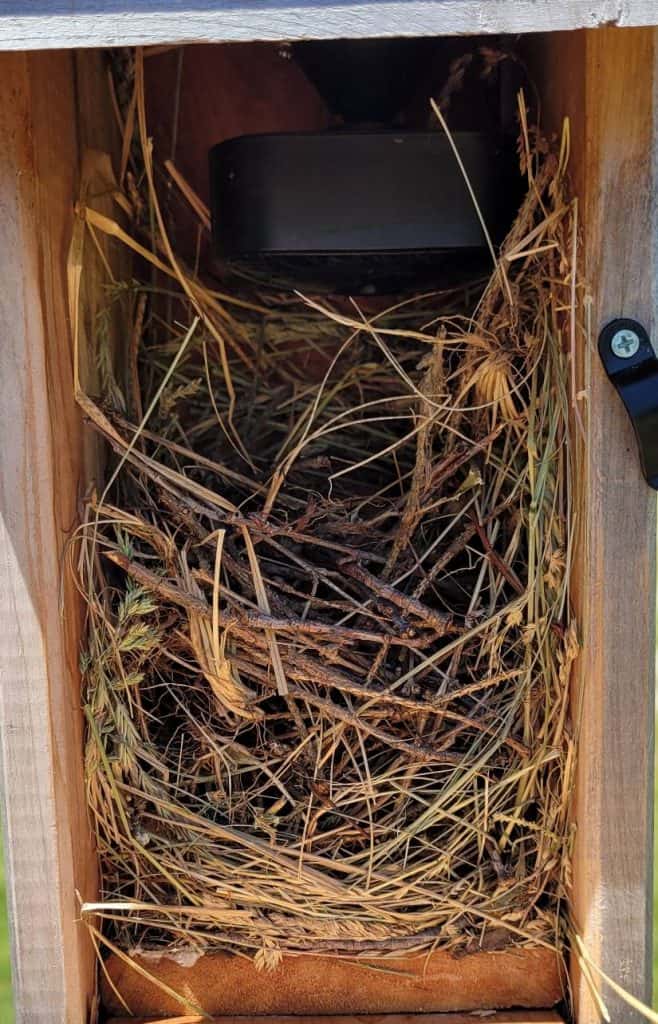
The bluebird nest is relatively shallow and tidy with grasses being the predominant material weaved around into a cup shape.
The house wren nest is very deep with an array of nesting materials haphazardly strewn across the top and stacked up almost to the top of the nesting box. Twigs are the predominant material of choice for house wrens but they also use grasses, feathers, and pine needles.
Bluebirds nesting Frequency
Bluebirds will have up to three broods in a given season. The female usually lays more eggs with the first brood – about 3-5 eggs. Subsequent broods are often 2-4 eggs each. The reason for this is likely due to the higher energy level and perhaps the health of the female at the start of the season.
Once all of the eggs are laid for a given brood, the female begins incubation which lasts 12-14 days.
Eastern Bluebird Nesting Overview
| Number of Broods | 1-3 per season |
| Number of Eggs | 3-5 eggs 1st brood of the season 2-4 eggs, subsequent broods of the season |
| Egg Description | Sky blue color (sometimes white) Approximately .8″ x .7″ in size |
| Incubation Period | 12 – 14 days |
| Appearance Upon Hatching | Naked, patchy areas of down |
| Fledging | Leaves the nest after about 21 days. |
Check out my in-depth article All About Eastern Bluebird Babies to discover what bluebird eggs look like, how long it takes bluebird eggs to hatch, what baby bluebirds look like, and a ton of photos and videos of adorable baby bluebirds.
FAQs Related to Bluebird Nesting
Do bluebirds sleep in their nest at night?
I did a little snooping and discovered Yes! bluebirds do sleep in their nest at night. Check out the short clip below of a sweet momma bluebird peering out the nesting box hole at around midnight.
Will bluebirds reuse a nest?
Eastern bluebirds will reuse the same nest – especially if it produced a successful brood.
Alternatively, she may use the same nesting site but build a new nest on top of the old one. This can be a dangerous approach since the nest will be closer to the entrance hole and easier for predators to reach the eggs or babies. This is why it’s crucial to remove the nest immediately after the babies have fledged.
Bluebird Nest Camera
If you’re interested in getting up close and personal with bluebirds during nesting you can install a non-intrusive nest camera. You never know what you’ll learn. There are a variety of camera options available and I tried several of them.
Blink Outdoor Wireless Cameras for Spying on the Birds
I decided the Blink outdoor wireless camera is the best choice for wild bird snooping – I have 6 of them throughout my yard and inside nest boxes. I use them to spy on the bird feeders, nesting boxes, nests in shrubs or trees, you name it!
The clip below is from a Blink camera I set up pointing toward a bluebird nesting box. My goal was to capture the babies fledging. My surprise was to see a cowbird baby fledging the nest!
Blinks are super easy to install and easy to use with the Blink app. They are wifi capable, and intended for outdoor use so are durable in all weather, and the batteries last 6 months or more (depending on usage).
You can get the cameras here: Blink Wireless Outdoor Camera.
They are made even more flexible with the mounting options available. The cameras come with a screw mount that is great for inside nesting boxes. I also buy clip and adhesive mounts to attach the camera to a tree branch, inside a small nest box (where the screw mount doesn’t fit), etc. Whatever you want to capture on camera is possible.
If you want to learn about the other cameras I tried for spying on birds, check out The Best Bird Feeder Camera To Snoop On The Birds.
In Conclusion
Eastern bluebirds are one of many wild bird species that use an existing cavity or manmade nestbox to contain their nest. Unlike the other secondary-cavity nesters, bluebirds build a tidy nest with a shallow cavity which enables us to easily distinguish them from the others. If your yard offers the wide-open habitat that eastern bluebirds prefer, and a nesting cavity, you have a good chance of hosting their family. It will be an experience like no other and one that you’ll seek out again and again.
Happy Birding!

